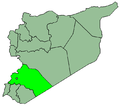Sakka, Rif Dimashq Governorate
 From Wikipedia - Reading time: 9 min
From Wikipedia - Reading time: 9 min
Sakka
سكا Saqqa | |
|---|---|
Village | |
| Coordinates: 33°26′0″N 36°27′22″E / 33.43333°N 36.45611°E | |
| Country | |
| Governorate | Rif Dimashq Governorate |
| Districts of Syria | Douma District |
| Nahiyah | Al-Ghizlaniyah |
| Population (2004 census) | |
• Total | 1,520 |
| Time zone | UTC+2 (EET) |
| • Summer (DST) | UTC+3 (EEST) |
Sakka or Saqqa (Arabic: سكا) is a village to the southeast of Damascus, on the edge of the Ghouta, 5 kilometres (3.1 mi) north west of Damascus International Airport in Syria.[1]
Tell Sakka
[edit]Tell Sakka is a man-made tell in the neighborhood that has been excavated by Ahmed Taraqji on behalf of the Directorate-General of Antiquities and Museums.[2]
Remains of a palace was found and dated to between 1800 and 1600 BCE. It has provided evidence of Egyptian influence in the Ghouta,[3] The architectural remains were said to resemble those of Qatna and along with pottery were dated to the Middle Bronze Age.[4] A courtyard was excavated measuring 14.5 metres (48 ft) by 22.5 metres (74 ft). Columns marked the entrance to the south and four large columns were positioned in a square in the centre of the courtyard. Tempera[5] or perhaps Fresco technique Paintings were found on the walls showing ancient Egyptian style and motifs.[6] However, beneath the apparent Egyptian scheme, a Near-Eastern tradition is evident in the ideas of the paintings.[7]
The first cuneiform tablet recovered in the Damascus area was found at Tell Sakka. It was suggested resemble the style of cuneiform found in the archives of Mari and speaks of a king called Zimri-Lim. The cuneiform tablet in Sakka was translated to read "To my brother Zimri-lim, say "Thus saith Kanhilesu? Your brothers Samas and Dagan for the rest of the days, My brother sustenance? In front of me (it is) good. In front of my brother that is well! I heard: The enemy of my country brother, My brother has attacked, news of him that sent me! (...) inside a (?) [..., The army [of my country?], to my brother [(go go)]."[8]
Other finds at the site included a sphinx made out of the scapula of a cow.[9]
References
[edit]- ^ Ross Burns (20 January 2005). Damascus: A History. Taylor & Francis. pp. 4–. ISBN 978-0-415-27105-9. Retrieved 21 September 2012.
- ^ Taraqji, A., "Nouvelles decouvertes sur les relations avec 1'Egypte a Tell Sakka et a Keswe, dans la region de Damas," Bulletin de la Société Française d'Égyptologie 144:27-43, 1999.
- ^ "à 12h30Tell Sakka, une ville du Bronze Moyen de Damascène (1800-1600), Syrie". louvre. Archived from the original on 16 April 2015. Retrieved 8 April 2015.
- ^ E. H. Bakraji, M. Ahmad, N. Salman, D. Haloum, N. Boutros, R. Abboud., Dating and classification of Syrian excavated pottery from Tell Saka Site, by means of thermoluminescence analysis, and multivariate statistical methods, based on PIXE analysis, Journal of Radioanalytical and Nuclear Chemistry, Akadémiai Kiadó, co-published with Springer Science+Business Media B.V., 1999
- ^ Manfred Bietak; Ernst Czerny; Österreichische Akademie der Wissenschaften (2007). The synchronisation of civilisations in the Eastern Mediterranean in the second millennium B.C.: proceedings of the SCIEM 2000-2nd EuroConference Vienna, 28th of May-1st of June 2003. Verlag der Österreichischen Akademie der Wissenschaften. ISBN 978-3-7001-3527-2. Archived from the original on 4 July 2014. Retrieved 21 September 2012.
- ^ Marlies Heinz; Marian H. Feldman (2007). Representations of Political Power: Case Histories from Times of Change and Dissolving Order in the Ancient Near East. Eisenbrauns. pp. 51–. ISBN 978-1-57506-135-1. Archived from the original on 4 July 2014. Retrieved 21 September 2012.
- ^ Joan Aruz; Kim Benzel; Jean M. Evans (2008). Beyond Babylon: Art, Trade, and Diplomacy in the Second Millennium B.C. Metropolitan Museum of Art. p. 129.
- ^ "Abdallah, Fayssal., La Découverte d'un Premier Texte Cunéiforme A Damas, Tell Sakka, Revision Historique, Damascus University Journal, Vol. 27, No. 3+4, 2011" (PDF). Archived (PDF) from the original on 18 April 2015. Retrieved 21 September 2012.
- ^ al Besso, Moussab., Production d'objets en os dans un atelier du Bronze Moyen en Syrie du Sud: Tell Sakka, Paper for the 10th International Archaeozoology of Southwestern Asia and Adjacent Areas, Brussels, June 28th-30th, 2011.[permanent dead link]
- Liebig, Michael (2014). "Zum Alten Namen von Tell Sakka". NABU: Nouvelles Assyriologiques Brèves et Utilitaires. 101 (4). Société pour l’étude du Proche-Orient Ancien: 133. ISSN 0989-5671.
External links
[edit]- Sakka on geographic.org
- Sakka on maplandia.com
- Sakka on mapcarta.com
- Sakka on tageo.com
- First report of the looting of the Archaeological mission to Tell Sakka on the Facebook page of Le patrimoine archéologique syrien en danger الآثار السورية في خطر, (Syrian Archaeological Heritage under threat)
- Photo of Tell Sakka on "Le patrimoine archéologique syrien en danger" Facebook page
- Louvre conferences - Tell Sakka, une ville du Bronze Moyen de Damascène (1800-1600), Syrie Archived 16 April 2015 at the Wayback Machine
 KSF
KSF

